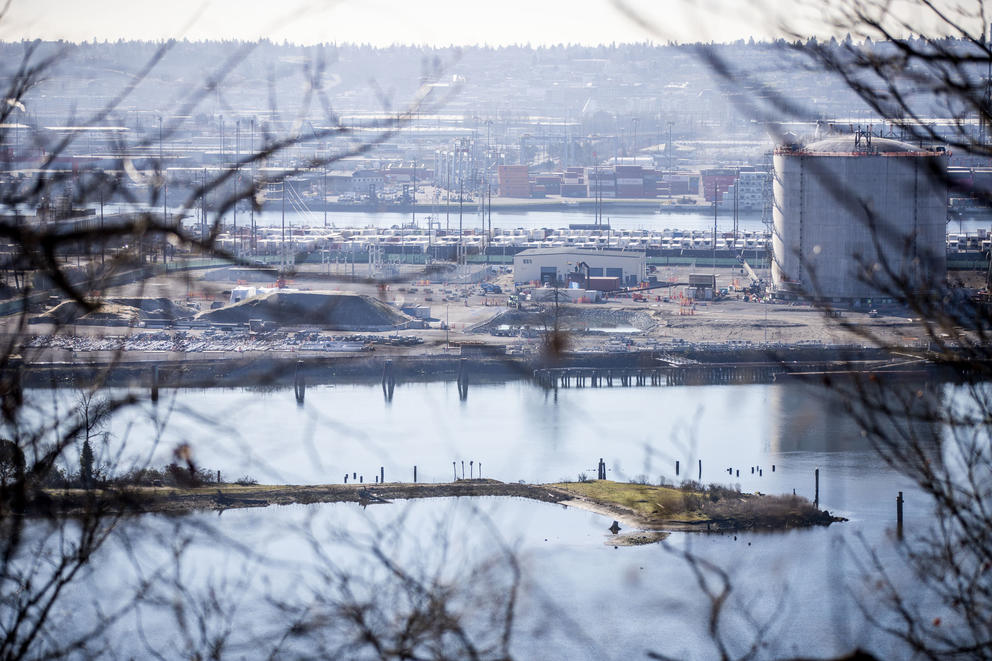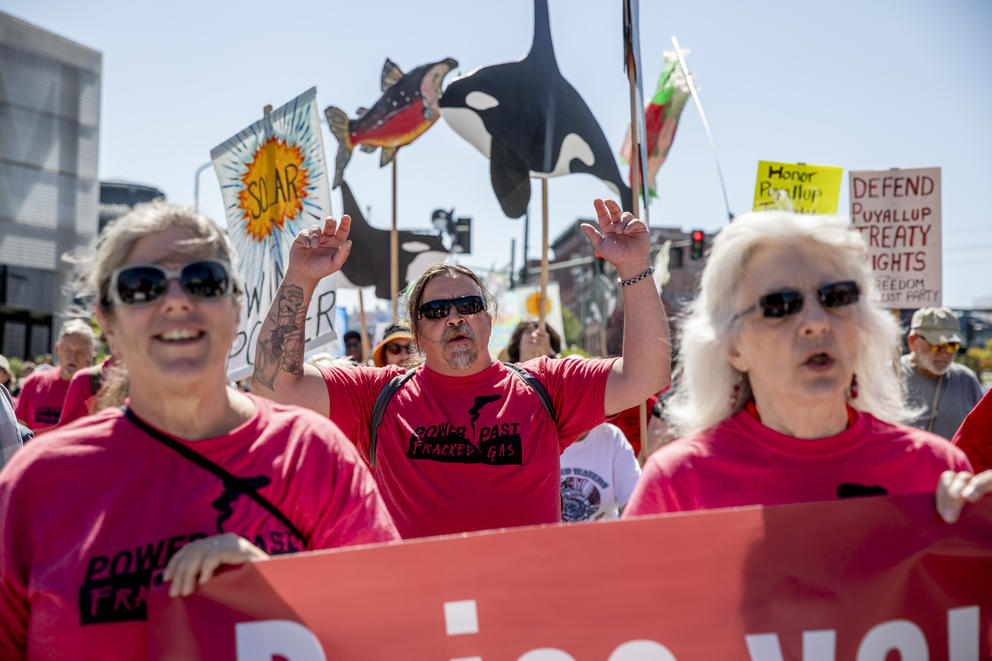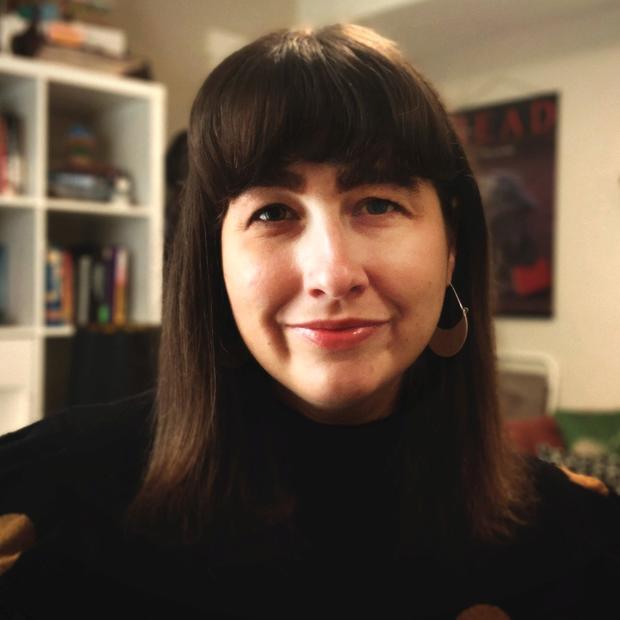“It’s not like in a James Bond movie or an art action, where somebody is, like, ‘Look at this vase,’ and it’s for whoever is the richest person in the room,” said Claire Boyte-White, the Department of Ecology’s cap-and-invest policy relations manager. “It’s actually the opposite of that.”
In its first year of implementation, under the Climate Commitment Act, passed in 2021, businesses convene through an online platform and propose how much they want to pay for each allowance, which is equal to one metric ton of carbon emissions. Facilities generating more than 25,000 metric tons each year must participate in the program or face fines of up to $10,000 per violation per day for noncompliance.
The Department of Ecology aims to cap emissions by offering a limited number of allowances at each auction. While awarded to the highest bidders, it is the lowest bid — before the allowances sell out — that sets the price. This round, the price for each allowance was set at $48.50.
The state sold more than six million allowances, totaling $300 million. The act requires that this revenue fund climate solutions, like electric vehicles, and invest in communities facing environmental justice concerns, like those overburdened by poor air quality. With three more auctions scheduled for later this year, the vitality of a new economic market will begin to unfold for businesses working to comply with the new law and local leaders hoping to put these dollars to work.
Paula Sardinas, founder of Washington Build Back Black Alliance, notes that because businesses can no longer pollute for free, people who live in communities near fossil fuel facilities could finally see investments in their health and livelihoods.
“They deserve to have a good environment with clean air and clean water, and they should be allowed to stay in their community with their familial relationships, their church, their school,” Sardinas said. She speculated that the money from the carbon auctions could be used for air monitoring, decarbonized affordable housing and electric school buses.
The law specifies that funds should be allocated toward “overburdened communities,” but which areas actually get the money for these environmental projects won’t be known until the Legislature makes its allocation decisions.
While the Department of Ecology has projected a multimillion-dollar cap-and-invest program – for example, they estimated $511 million in 2023 – Boyte-White can’t predict how engaged future auctions will be.
“We’re excited to see the program working so effectively with robust participation and demand, but it’s one data point,” said Boyte-White. “We anticipate both participation and prices to ebb and flow. It’s important to not get carried away with the narrative of how much it's going to be because each auction is unique.”
‘Only the beginning’
Washington’s new law aims to aggressively lower carbon emissions, the main culprit behind manmade climate change. The Department of Ecology created an emission reduction target — “the cap.” Each year, the state lowers the cap and reduces the amount of allowances available, with the goal of slashing emissions by 95% in 2050.
While cars and freight vehicles emit significant emissions in Washington, the cap-and-invest program focuses on businesses because of the density of pollution that comes from their facilities. One metric-ton allowance is the equivalent of someone driving their car 2,500 miles, or about 20 roundtrips from Seattle to Olympia.
Additionally, other greenhouse gases are included in the auction, like methane, and businesses must buy more allowances to compensate for its potency, which is often higher than carbon’s.
The state’s Climate Commitment Act implementation program manager, Luke Martland, who works with Boyte-White, said that Ecology designed a flexible program to be a sustainable market. Heavy manufacturers either purchase allowances at auction or trade them with other businesses. Some agencies or companies, like electric and natural gas utilities, will get allowances for free because they are not seeking to make a profit. Examples include Seattle City Light.
Over the past year, Martland and his team have been preparing for the auction through education and outreach. His strategy has been rooted in enforcing the program rather than trying to change opinions in the fossil fuel industry, which has mixed attitudes toward the new regulation.
“Our approach was more, ‘The law’s the law, and we’ll explain it to you, we’ll make sure you know how to comply, we’re here to help you, but the law’s the law,’” Martland said. “We didn’t get into, ‘Is it a good law? A bad idea? Somewhere in between?’ We really tried to divorce ourselves from that and focus on implementation.”
Martland wasn’t surprised that Western States Petroleum Association, a lobbyist group that represents oil companies, released a scathing assessment of the first auction. The group strongly opposed the cap-and-invest bill while it was being discussed in the Legislature, and this opposition prompted some companies like BP to leave the trade association in pursuit of partners who supported strategies to reduce or offset carbon emissions.
BP’s Cherry Point refinery in Blaine, among the largest emitters in the state, went on to support the Climate Commitment Act and has been taking steps to decarbonize, according to the Department of Ecology. Eric Zimpfer, vice president of refining at the Cherry Point location, said in a written statement that he feels proud of the work BP did to support the passage of the act.
“But passing the law and participating in the rulemaking is only the beginning. So we continue to work with all parties to ensure the program is an ongoing success,” Zimpfer wrote.
BP and several other companies Crosscut reached out to didn’t comment on their experience with the auction or its prices. Only Western States Petroleum Association has publicly expressed concern — specifically about allowances settling at a price of $48.50 each, after Ecology had set a minimum allowance price of $22.50 in the months leading up to the auction. In an email to Crosscut, WSPA spokesperson Jessica Spiegel said the program is too extreme compared to California’s program, whose allowances sold for $28.85 each in February.
California’s market is five times the size of Washington’s, and that is partially why the allowances sold for less, according to Boyte-White. The Department of Ecology is exploring merging Washington’s auction into California’s for a larger western market, which could drive down prices in the future.
‘Meeting the Moment’
Washington modeled its cap-and-invest program after California’s, which began nearly a decade ago, but Washington is aiming to reduce in 30 years what California did in 50. When its program started, California’s initial emissions reduction started with a softer target goal than Washington's, and California worked nearly six years on its program design in collaboration with the business community and environmental groups.
As Washington experiences the effects of climate change now — like wildfires and sea-level rise —the state doesn’t have much time to ramp up the program, say environmental advocacy groups like Washington Conservation Action.
“We started hard and fast because we met the moment,” said Cliff Traisman, the organization’s legislative lobbyist. “A moment where we are in crisis and the impact is on all Washington citizens, especially those in the frontline communities.”
Through its program, California met its goal of reducing the amount of emitted greenhouse gases to levels below those of 1990, according to an inventory report. However, the California Air Resource Board admits the state still needs to bring down emissions by another 40% by 2030.
Also, environmentalists have been critical of California’s program, which they believe allows businesses to buy themselves out of lowering emissions. A panel that advises California regulators reported that businesses are accumulating unused credits due to temporary decreases in economic activity and emissions during the pandemic. Should businesses use those credits in quick succession, a possible scenario with inflation, it will be challenging for California to meet its carbon-reduction goals.
Eventually, Washington will need to evaluate its own cap-and-invest program to ensure it is effectively reducing emissions.
“All bedrock environmental laws eventually get amended,” Traisman said. “If anything, it would likely be over time to make sure we’re actually meeting our climate reduction goals. That’s the whole idea. Over time we will ask, Is this working? Is it aggressive enough? We won’t know right away.”
Traisman said the most important work now is how the Legislature allocates and spends the auction revenue in a way that people can experience soon.
The Legislature could start calculating their budgets as soon as the last week in March, when the Washington State Treasury receives the auction revenue from the Department of Ecology.
Then the bidding starts again.





